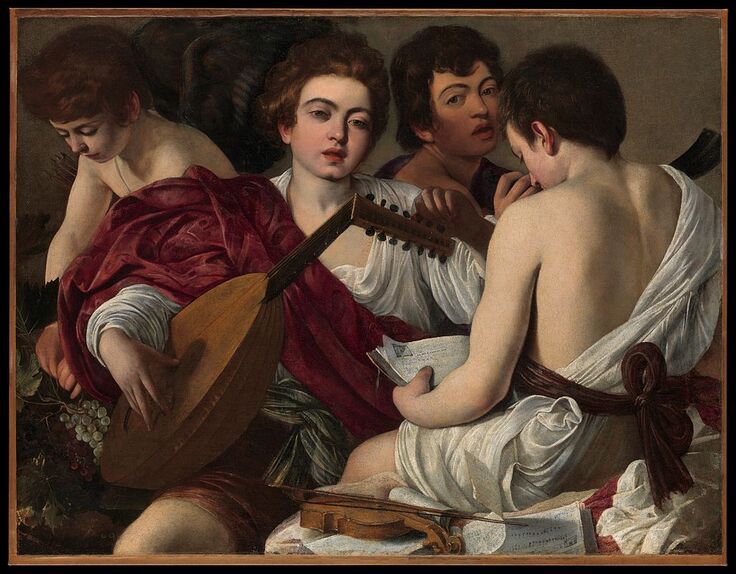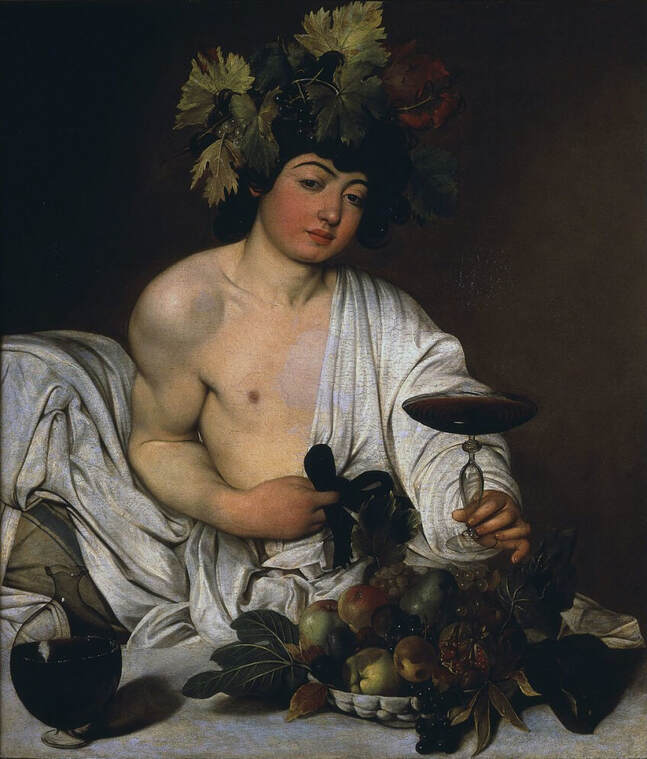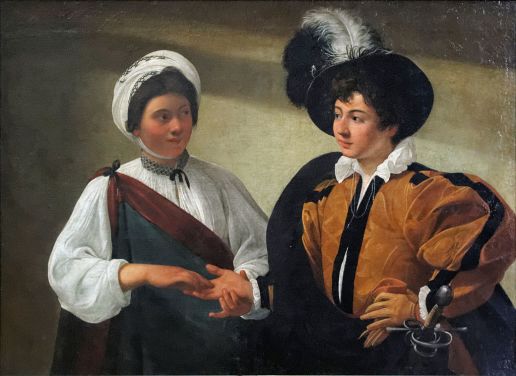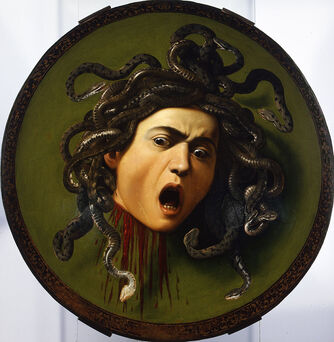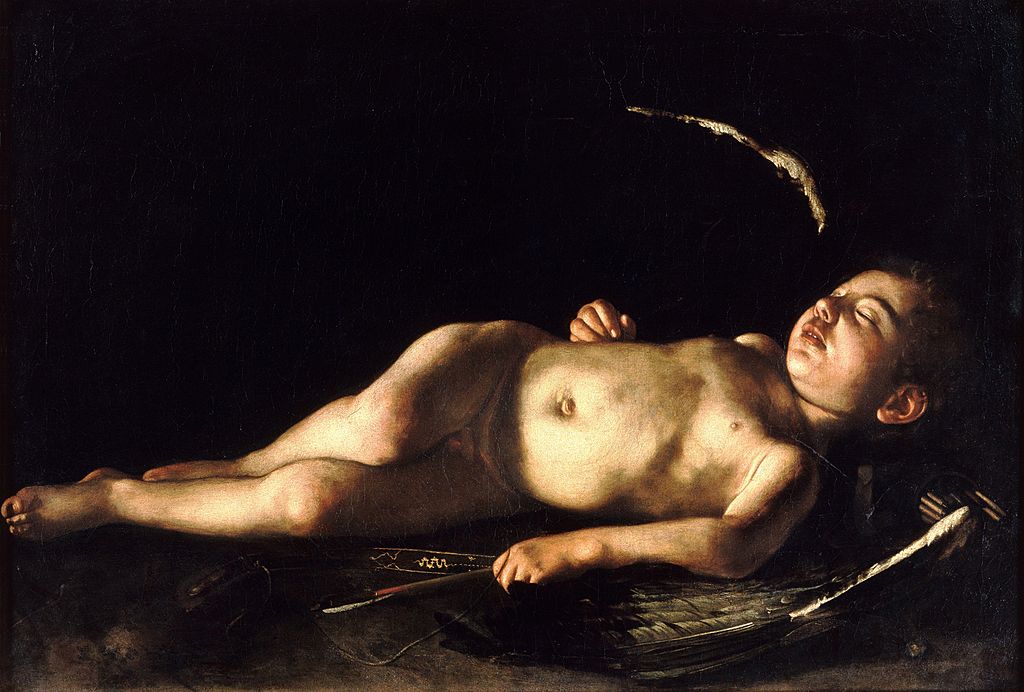|
Where? Room 621 of the Metropolitan Museum of Art
When? 1595 Commissioned by? Cardinal Francesco Maria del Monte, the patron of Caravaggio. What do you see? Four boys dressed in semi-classical costumes. Three of the boys are playing music. The central figure is holding a lute and is thought to be Mario Minniti, a friend of Caravaggio. His eyes are moist and full of tears. The second boy from the right is a self-portrait of Caravaggio, who is playing a cornetto (a horn-like wind instrument of about two feet long; you can see the end of the instrument on the top right of the painting). The boy on the right is studying the musical score. The boy on the left is representing Cupid and is reaching for some grapes. In the foreground are two open books with musical scores as well as an unused violin. These elements seem to invite the viewer to participate with the musicians. Backstory: This painting is also known as the Concert of Youths. The boys are practicing madrigals, which are a secular (as opposed to religious) vocal music composition from the Renaissance. The song they are practicing deals with the sorrows of love. Symbolism: The boy on the left represents Cupid. The gathering of grapes by Cupid represents love. The grapes are also representing the fact that music should make the spirits light. Cupid has wings and arrows. The arrows are the main symbol of Cupid (together with the bow). Cupid typically has two kinds of arrows. Arrows with a sharp golden tip, which can fill someone with uncontrollable desire, and arrows with a blunt tip of lead, which can fill someone with aversion and the desire to flee. Cupid seems to have the latter type of arrows here. Why musicians? Musical scenes became popular during Caravaggio’s time, mainly due to the Church that started supporting various forms of music. Hence, the inspiration for this theme came from Cardinal Del Monte, who was heavily involved with the Church. Del Monte also organized various concerts at his palace. However, interestingly, the music that is played in this painting is nonreligious. Who is Francesco Maria del Monte? At age 24, Caravaggio entered the household of the Italian cardinal, diplomat, and art connoisseur, Francesco Maria del Monte (1549-1627). The cardinal paid Caravaggio for his work. Del Monte was an important art collector during his time in Rome and left a collection of about 600 paintings at his death. He commissioned more paintings from Caravaggio, including Bacchus (in the Uffizi Museum) and The Fortune Teller (in the Louvre). In addition to his love for paintings, Del Monte was also a big fan of music which explains the musical theme in this painting. In his large house, the Palazzo Madama, the cardinal hosted both artists like Caravaggio and various musicians. He paid for their musical education and gave them a place to stay.
Who is Caravaggio? Michelangelo Merisi da Caravaggio (1571-1610) was trained by Simone Peterzano, who was in turn trained by Titian. He used a realistic painting style, paying both attention to the physical and emotional state of the subjects he painted. He combined this with a brilliant contrast between light and shadow in his paintings.
Caravaggio lived a tumultuous life and was accused of murder, assault, many fights, and has served in prison. However, his sheer brilliance as an artist has given him a place in the history books. His painting style has had a big influence on the development of Baroque painting (which includes drama and an intense contrast between light and dark). Some well-known paintings by Caravaggio are his Medusa in the Uffizi Museum and Sleeping Cupid in the Palazzo Pitti.
Fun fact: This painting has been missing for centuries. While many artists in the 17th century mentioned this masterpiece, it only turned up in 1952, when the Metropolitan Museum of Art announced that the painting had been found and they included it in their museum. Less than two decades before, the painting had been sold for 100 pounds in England, where both the buyer and seller did not recognize that this was the missing painting of Caravaggio (mainly due to the bad state in which the painting was).
Interested in a copy for yourself? Poster or canvas.
Written by Eelco Kappe
0 Comments
Leave a Reply. |
Categories
All
|
- Home
- Blog
-
Museums
- Alte Pinakothek
- Art Institute of Chicago
- Baltimore Museum of Art
- Barber Institute of Fine Arts
- Bargello
- Barnes Foundation
- British Museum
- Church of Sant’Anastasia
- Cleveland Museum of Art
- Courtauld Institute of Art
- Detroit Institute of Arts
- Frans Hals Museum
- Galleria Borghese
- Gallerie dell'Accademia
- Getty Museum
- Guggenheim
- Hermitage Museum
- Kunsthistorisches Museum
- Kunstmuseum Basel
- Legion of Honor Museum
- Louvre
- Mauritshuis
- Metropolitan Museum of Art
- Musee d’Orsay
- Museum of Fine Arts in Boston
- Museum of Modern Art
- National Gallery in London
- National Gallery of Art
- National Museum in Poznań
- Norton Simon Museum
- Ny Carlsberg Glyptotek
- Palace of Versailles
- Palazzo Pitti
- Palazzo Vecchio
- Petit Palais
- Philadelphia Museum of Art
- Prado
- Pushkin Museum
- Ravenna Art Museum
- Rijksmuseum
- San Diego Museum of Art
- Santa Maria delle Grazie
- St. Peter's Basilica
- Städel Museum
- Statens Museum for Kunst
- Tate Britain
- Tate Modern
- Timken Museum of Art
- Uffizi
- Vatican Museums
- Wallace Collection
-
Artists
- Altdorfer
- Anguissola
- Berlin Painter
- Bosch
- Botticelli
- Boucher
- Bronzino
- Bruegel the Elder
- Brunelleschi
- Cabanel
- Caillebotte
- Canova
- Caravaggio
- Carpeaux
- Cezanne
- Cimabue
- David
- Degas
- Delacroix
- De Maria
- Donatello
- El Greco
- Fontana
- Fra Angelico
- Fragonard
- Gauguin
- Gentileschi
- Gericault
- Gonzalez-Torres
- Goya
- Hals
- Hogarth
- Hokusai
- Ingres
- Leonardo da Vinci
- Lippi, Filippo
- Longhi, Barbara
- Lorrain
- Makovsky
- Manet
- Massys
- Matisse
- Merian
- Michelangelo
- Mochi
- Modigliani
- Monet
- Panini
- Parmigianino
- Perugino
- Picasso
- Pisanello
- Raphael
- Rembrandt
- Renoir
- Reynolds
- Rivera
- Rodin
- Rubens
- Scultori
- Seurat
- Steen
- Tintoretto
- Titian
- Toulouse-Lautrec
- Turner
- Uccello
- Van der Weyden
- Van Dyck
- Van Eyck
- Van Gogh
- Van Hemessen
- Vasari
- Velazquez
- Vermeer
- Veronese
- Vigée Le Brun
-
Locations
- Books
- About Us

